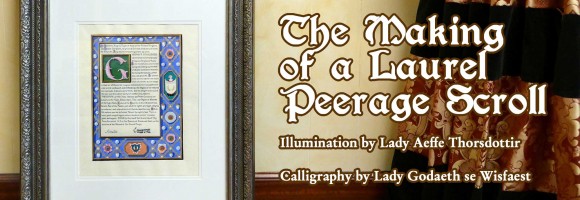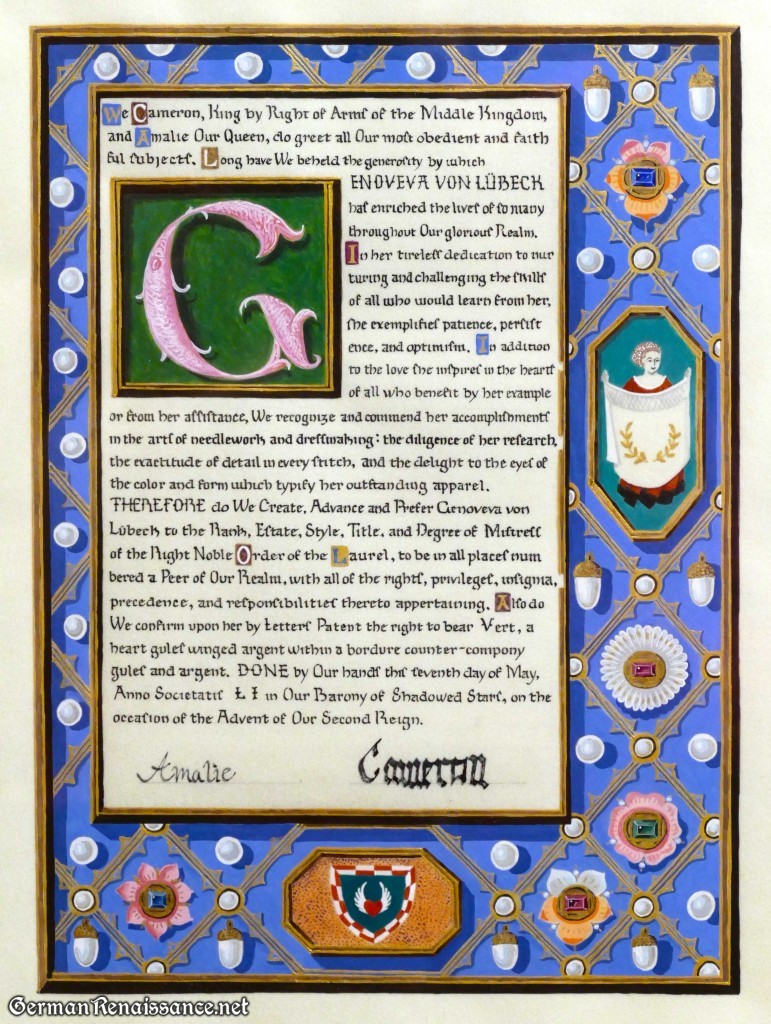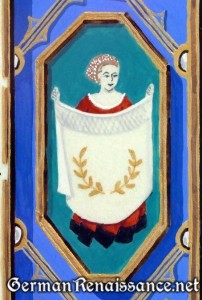
When I was placed on vigil to join the Order of the Laurel, I thought carefully about who I would ask to make this important scroll. I am fortunate to know many, many talented and well-recognized scribes. After some deliberation, I decided to start off as I intend to go on in my career as a Laurel, during which time I hope to continue to foster the arts and sciences, and I picked two up-and-coming scribes who show great promise: Lady Godaeth and Lady Aeffe. Not sure who they are? I hope by the end of this article, you have some inkling of the wonderful attributes and talents I see in them.
With my decision made, I asked Gregor to contact them on my behalf to request the commission. I knew this would be their first peerage scroll and thus it would be a challenge, which was precisely my hope for them. I requested only that my scroll be based on a period source and that it be appropriate to my persona. All other decisions were made between Godaeth and Aeffe, with occasional input from Gregor. I kept my input low, and I could have been sorely disappointed in the outcome. I was taking a big chance. But, I had faith in these two artisans. Here is the gorgeous scroll that was read into court during my ceremony to join the Order of the Laurel:

What was the inspiration for this scroll? Lady Godaeth explains that they “always try to select an exemplar specific to the period, culture, etc. of the persona of the person receiving the award. In the case of Meisterinne Genoveva, we settled on a Flemish manuscript in the Getty Museum by an Unknown artist, ca. 1525-1530.” The page dimensions of the extant scroll are 6 ⅝ x 4 ½, which is about the size of a page from a trade paperback. The extant scroll was made with tempera colors, gold paint, and gold leaf on parchment.
 Lady Aeffe illuminated the scroll, and you’ll note the striking similarity to the extant scroll with notable and personal differences. Aeffe explained that the “original image of Veronica holding up her veil with its miraculous image of Christ’s face was changed to a miniature of you [Genoveva], in your distinctive dress, holding up a pleated piece of fabric with a Laurel wreath in lieu of Christ’s face.” That was a stroke of brilliance, for pleatwork is my passion. I’ve included a closeup of that part of the scroll so you can admire the artistry. You’ll also note my arms appear at the bottom in place of the Lamb of God. The plethora of pearls and gems are particularly appropriate to my persona. And, though it wasn’t planned, the acorn is a symbol of my Laurel’s (Mistress Crespine’s) sisterly household. The acorn is also the very first award token I ever received in the Barony of Cynnabar.
Lady Aeffe illuminated the scroll, and you’ll note the striking similarity to the extant scroll with notable and personal differences. Aeffe explained that the “original image of Veronica holding up her veil with its miraculous image of Christ’s face was changed to a miniature of you [Genoveva], in your distinctive dress, holding up a pleated piece of fabric with a Laurel wreath in lieu of Christ’s face.” That was a stroke of brilliance, for pleatwork is my passion. I’ve included a closeup of that part of the scroll so you can admire the artistry. You’ll also note my arms appear at the bottom in place of the Lamb of God. The plethora of pearls and gems are particularly appropriate to my persona. And, though it wasn’t planned, the acorn is a symbol of my Laurel’s (Mistress Crespine’s) sisterly household. The acorn is also the very first award token I ever received in the Barony of Cynnabar.
Lady Godaeth was both the author of the text and the calligrapher. According to Godaeth, her biggest challenge was “engineering the appropriate wording for the space available. ” On the exemplar there are 19 lines of fairly big text on a tiny page! Godeath explains that on my scroll, to cover all the necessary elements and express the true circumstances of the recognition, “it took 236 words and had to fit in a relatively small frame of glorious artwork (when done). The finessing of wording and lettering gauge (line height + letter height + capitals / margin space) remained dynamic to the very end. Plus of course, text breaks had to fall “just so.” I tried to create some period-looking margin intrusions but failed to get a picturesque “bulge.” I made one draft on Bristol paper and then two on Perg. My first “keeper” I didn’t like so I started over after the first line of text.”
The text wording is based on the standard Midrealm Laurel text but amended in several places for a more 16th-century feel. Godaeth says, “The greeting and closing were brief so I could develop in (relative) detail the two dimensions of the recipient’s greatest impact (in my opinion) on the Kingdom Populace, as I have experienced them: in her role as teacher and role-model, and her well-known achievements in dressmaking, etc. There are three words in the first of those two paragraphs — persistence, patience, and optimism — that are to me, the very by-words of any serious and sincere involvement in the SCA, Inc. Many, many times have I personally benefited from meditating on how Meisterinne Genoveva demonstrates those very qualities. The conveyance was borrowed from a scroll from another kingdom … but I found many examples of such wording in 16th century Court Rolls of Tudor England.”
And we are all—Godaeth, Aeffe, Gregor, and I—grateful to Baron Ermenrich for heralding the scroll text at my Laurel Ceremony. Godaeth put it best: “I am indebted to His Excellency Ermenrich von Duisberg, a proper German persona, who set aside his Coronet as Baron of Cynnabar, to herald the scroll text. Whatever words are put in the mouth of Their Majesties, it’s the herald who ultimately ‘performs’ them.”
I am overjoyed to be the recipient of this priceless piece of art. Thank you, Godaeth and Aeffe, for rising to my challenge and making my world look and sound more beautiful than it already is. I look forward to all of your future endeavors!

Congratulation on your Laurel! It is greatly deserved! You do such excellent work!
Your scroll is truly a work of art! You are lucky to have these ladies to create it for you!
You are also an excellent teacher! I have learned so very much from your blog here.
Thank you! Lady Cate